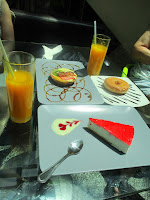The sign read
‘rambling roses unleashed’ and that's what you get from Moor Wood owners Henry
and Susie. This two-acre country garden is home to more than 150 varieties of
rambler roses from The National Collection, as well as many other varieties.
You just ramble among the roses at Woodmancote nostrils filled with the heady
scent of the many blooms.
Tuesday 28 June 2016
Malaga Musings
First time
trip to Malaga with Sis Jean and friend Judy. Stayed just off the Place de la
Merced, birthplace of Picasso, in a wonderful apartment overlooking the castle
on the hill owned by the lovely Vincentes -
father and son. Amongst the many advantages were the nearness to restaurants
and shops off the square, most of the old town and the beach being within
walking distance, ample affordable taxis and wall to wall sunshine.
 |
| Judy n Jean with new friend Pablo |
Malaga is
dominated by Castillo de Gibralfaro and the fortification of Alcazaba. We could
see the castle on the hill from the balcony of our apartment. Two thirds of the
way up the steep path to the castle is an impressive viewing platform. Not only
are the views spectacular but on a clear day you can see the coast of Africa.
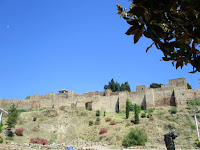
The Castle
was built in the 14th. Century to house troops and protect the Alcazaba It was
named after a lighthouse at its peak (Jabal-Faruk, the light mountain).
Although it was used by the Phoenicians and Romans, in 1340 the Nasrid King
Yusuf I made the place into a fortress. The main courtyard and houses the
Interpretation Centre housing the history of the castle. It is possible to walk
the high battlements to the tall tower with its panoramic views.


According to
Arab historians the Alcazaba was built between 1057 and 1063 at the
instructions of Badis, King of the Berber Taifa of Granada. The building's
military components make it one of the most important Muslim works in Spain
today.
Málaga's
Roman Theatre, in front of the Alcazaba, is one of the remaining symbols of
Roman Hispania in the city. The Theatre has been returned to its original use
and different types of shows take place inside.
In much the
way the Castle dominates the hill the Cathedral dominates the old town. Its
full name is Nuestra Señora de la Encarnación (Our Lady of Incarnation).
The foundations were laid around 1530 and work ended in the 17th century, although
it is unfinished and lacks coping on the main façade and the south tower. The
missing tower has led to it being popularly known as La Manquita (one-armed).


The green spaces between the castle and the main beach are like miniature botanic gardens in themselves, similarly the Cathedral gardens.


This in contrast to the main beach, not the best on the Costa - murky water, few resources but OK for an hour or two on a recliner under an umbrella.

The trip to Gibraltar was a smidge long but the luxury air con coach
ambled through the Costas down the coast. As we had never been before it proved
an interesting trip. It is believed that as Neanderthals developed into
Homosapians and moved north through Africa the caves in Gib was believed to be
their first European settlement. After negotiating the Spanish and British
border controls (Brexiteers get used to this soon no longer the EU Citizens
fast track for us!) your on La Roc.
After a
wander round town, somewhat reminiscent of Cheltenham, we boarded a mini bus
with driver and tour guide par excellent Jesus (heisus) – he said we were to
tell people we had been driven round Gib by Jesus :) . It’s a trip well worth
taking :)
The sensible
people of Gib led a very enthusiastic ‘In’ campaign during the EU Referendum,
but they had more than most to lose. Having held off one blockade by Spain with
the help of Morocco they are about to face another demand for its return.
Amongst their current privileges:
- Subsidised marine fuel forms a mainstay of their economy with Med shipping calling in to refuel;
- Major tax concessions;
- If their offspring pass their A levels they get shipped to GB and their Uni fees paid, providing they finish their course, with no other strings attached;
- Advantageous OAP social care.
Churchill
reckoned that the Brits would be on Gib as long as the monkeys were there, they’re
still there. Must admit, geographically, Gib should be part of Spain – but then
Spain controls the Canary Isles, just off the coast of Africa, and makes
similar financial/economic concessions to them. Post colonial hangovers forever
causing problems.

The trip around the rock again took in amazing views and as with the stunning St Michael's Caves, pictures can’t do it justice. The acoustics in the main cave are so good the chamber is now used for concerts.

The war caves are more depressing. Around 1k
people died constructing the miles of war caves hewn out of the rock by hand held
pneumatic drills. In the end Franco refused to bomb and Mussolini failed to
turn up so the rock was never attacked.

All too soon it was time for the trip back to Malaga and tiffin :-p

Saturday 18 June 2016
Monday 13 June 2016
Midsummer Gardens
An almost perfect combination of warm spells, occasional rain and lack of strong wind has brought forth a mass of garden colour - both blooms and blossom.
Longhope Gardens


Longhope Gardens
In a small
Gloucestershire village, sited in valley with wonderful views, 4 well planted
gardens with different planting styles were open to the public:
Chessgrove
Cottage a delightful garden with spectacular views and access to 12 acres of
surrounding woodland.
3 Church Road
was long garden divided into rooms with large collection of hardy
geraniums.
Springfield House, a large enclosed terraced
garden with wide variety of shrubs and trees mingling with sweeping borders and
a wildlife pond.
Woodbine Cottage
was a tranquil garden with traditional planting.

Hanley Swan Gardens
Just over the
border, in Worcestershire, we found five assorted gardens in Hanley Swan. The
village green was bedecked with bunting and covered in stalls celebrating someones 90th birthday.
Blackmore
Grange was by far the largest. A two acre informal garden packed with tradition, plants,
shrubs and trees. A swimming pool has been transformed into the stable yard
garden, with traditional cottage-style planting. There’s a woodland walk, wild
area, orchard, kitchen garden and mixed borders.

Chasewood has
lavender and old fashioned roses. A gravel garden with an Iris and Thyme
walk, a collection of Bonsai and Coach Built Prams.
Meadow Bank
is a modern interpretation of a cottage garden, with a hot border, Dahlias
grown and collections of Iris and Auriculas.
The Paddocks
is a wildlife garden with ponds, a tadpole nursery, mixed borders, and a
collection of cacti and succulents.
19 Winnington
Gardens, one of our favourites, is a garden of rooms. Mixed borders for all
seasons enclosed with climbing roses, a small oriental garden, trained fruit
trees, raised herb bed with a special standard gooseberry bush. Not to mention
the venue for tea n cake J
Atcombe Court
Finishing back nearer home, at South Woodchester, we find Atcombe Court a 12-acre
grounds around C17 house with later, yet imposing, Regency front with incredible views over the Stroud valley, also comprises lakes, mature trees and paddocks. There are terraced herbaceous borders, lawns, extensive shrubberies, cutting garden
mostly annuals and a long peony border. Backing onto Atcombe there are woodland
walks through Beechwood.
Wednesday 1 June 2016
Munich Meanderings
Should've flown the dragon! After a v delayed start we were up n away for a long weekend break in Munich. Some time back we saw a TV prog about the castles of King Ludwig II and decided to go see for ourselves.
Stayed at the Atlas City Hotel. A small but perfectly formed budget hotel in the heart of Munich, yet surprisingly quiet at night. Munich has one of the best integrated/affordable public transport systems and the hotel is ideal for tram/bus/U & S bahn.
Also, much like Tokyo, the city has some large urban green spaces that can transport you from the bustle of city life to tranquil green spaces. The Englischer Garten is an amazing space with long walks, lakes and a large picnic area around the pagoda.
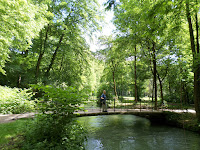
The architecture in the city varies greatly between the gothic and the almost brutal, some picturesque some large square concrete blocs.
Meanwhile back at King Ludwig II. Born 1864 and became Crown Prince of Bavaria at age 18. He passionately believed in the divine right of kings and besotted by Richard Wagner - the latter being the inspiration for the castles at Neuschwanstein, Linderhof and Herrenchiemsee. The lavish expenditure on these projects led Ludwig to bankruptcy and his untimely death in Lake Starnberger (did he fall or was he pushed, the mystery has never been solved).
Linderhoff was conceived after Ludwigs visit to Versailles in 1687. Ludwig became enchanted by the concept of the Sun King. This was the only building project Ludwig saw to completion and became his favorite residence.

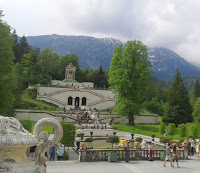
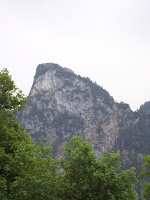
The tour took us through some picturesque countryside in the foothills of the Bavarian Alps

Perhaps the most scenic, and probably the most devout, was Oberammergau. Famous for its ten yearly Passion Play (lasts around 7 hours) since 1634 - designed to keep the plague away from the village. Many houses and shops are air painted mainly with religious scenes.
Neuschwanstein (Swan Rock) was built between 1869 and 1886 above Alpsee Lake. This five story castle built in Romanesque style contains many lifesize scenes from Wagner operas - including an internal grotto. These projects bankrupted Ludwig, the State decided to remove him and he was later found drowned in mysterious circumstances. The irony is that now Neuschwanstein now draws in enough tourist revenue to support all of Bavaria's castles. The steep climb up is well worth the effort, or alternative horse n cart for the less adventurous.


The views from the castle balconies are equally as stunning -

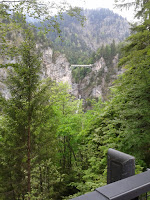
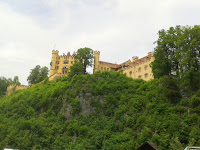
The castle in the background, Hohenschwangau, was his fathers.
On the way back we drove through the most amazing 'tropical' storm. Within two minutes the temp dropped from 23 to 13C, hail/thunder/lightning and water cascading off the bus. Within 20 mins all back to normal.
Meanwhile, back in the City, rest and some sustenance -

a tour of the main market + some familiar places -
 |
| many towns/villages have these maypoles the icons show whats available bakers/inns/butchers et al |

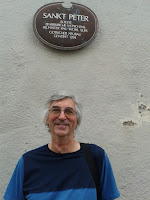
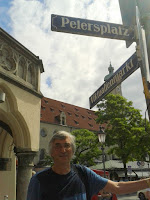
Then onto a palace within the City. The baroque palace of Nyphenburg was the summer residence of the Bavarian monarchs. Five generations of Wittelsbach rulers were involved in the construction which houses several outstanding collections. With its lavishly decorated interior and the famous "Gallery of Beauties" commissioned by Ludwig I, it contains the former bedroom of King Ludwig II and the impressive banquet hall with fine ceiling frescoes by Johann Baptist Zimmermann.

 |
| the very bed |
There are extensive garden walks down to the 'cascade'.


and so to the final evening.
Subscribe to:
Posts (Atom)





















